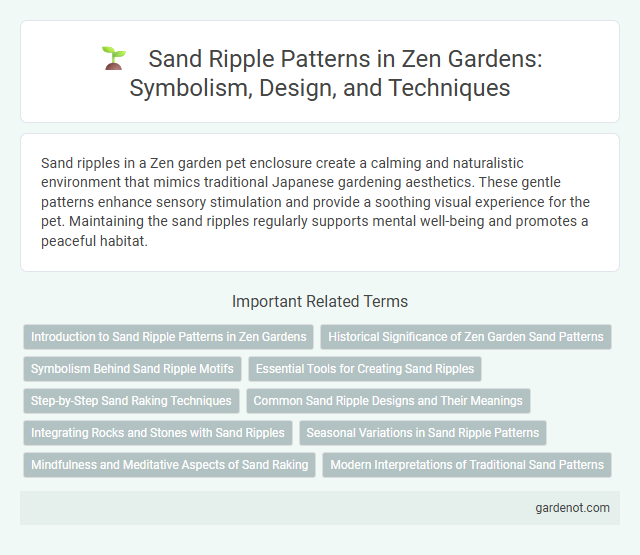Sand ripples in a Zen garden pet enclosure create a calming and naturalistic environment that mimics traditional Japanese gardening aesthetics. These gentle patterns enhance sensory stimulation and provide a soothing visual experience for the pet. Maintaining the sand ripples regularly supports mental well-being and promotes a peaceful habitat.
Introduction to Sand Ripple Patterns in Zen Gardens
Sand ripple patterns in Zen gardens symbolize the flow of water and the natural movement of air, creating a tranquil and meditative atmosphere. These meticulously crafted ripples, etched using wooden rakes, enhance the garden's aesthetic while encouraging mindfulness and reflection. The repetitive, soothing design fosters a deep sense of calm and connection with nature.
Historical Significance of Zen Garden Sand Patterns
Sand ripples in Zen gardens symbolize the flow of water and embody centuries of Japanese cultural heritage, reflecting Zen Buddhism's emphasis on meditation and tranquility. These meticulously raked patterns trace back to the Muromachi period, serving as both artistic expression and spiritual practice. Their historical significance lies in fostering mindfulness and illustrating natural harmony through minimalistic design.
Symbolism Behind Sand Ripple Motifs
Sand ripple motifs in Zen gardens symbolize the flow of water and the impermanence of life, reflecting constant change and tranquility. These meticulously crafted patterns promote meditation and mindfulness by encouraging focus on the present moment's natural rhythms. The simplicity and repetition in ripple designs foster a deep connection to nature's cycles and the Zen philosophy of harmony.
Essential Tools for Creating Sand Ripples
Essential tools for creating sand ripples in a Zen garden include a wooden rake with evenly spaced tines designed to sculpt precise patterns and a flat board for smoothing the surface. High-quality, fine-grained sand enhances ripple definition while maintaining texture stability. Using these tools ensures the harmonious flow and meditative quality central to traditional Zen garden aesthetics.
Step-by-Step Sand Raking Techniques
Creating perfect sand ripples in a Zen garden involves precise step-by-step sand raking techniques to evoke tranquility and harmony. Start with a clean, level surface, then use a specialized rake to draw evenly spaced, curved lines that mimic the flow of water. Maintain consistent pressure and rhythm to produce smooth, flowing patterns that enhance the garden's meditative ambiance.
Common Sand Ripple Designs and Their Meanings
Common sand ripple designs in Zen gardens, such as concentric circles, parallel lines, and wave patterns, symbolize tranquility, flow, and the interconnectedness of nature. Concentric circles often represent ripples in water, promoting meditation and mindfulness. Parallel lines mimic the ocean's waves, fostering a sense of calm and continuous movement.
Integrating Rocks and Stones with Sand Ripples
Sand ripples in a Zen garden are carefully sculpted to highlight the natural beauty of rocks and stones, creating a harmonious interplay between solid and fluid elements. The patterns of the sand mimic water currents, emphasizing the placement and form of each rock to evoke tranquility and balance. This integration enhances the garden's meditative atmosphere, inviting contemplative reflection through the visual contrast of textures and shapes.
Seasonal Variations in Sand Ripple Patterns
Seasonal variations in sand ripple patterns within Zen gardens reflect changes in environmental factors such as wind intensity, humidity, and temperature. During spring and summer, increased moisture and gentle breezes create finer, closely spaced ripples that enhance tranquility. In autumn and winter, stronger winds and drier conditions produce broader, more pronounced ripple formations, emphasizing natural rhythm and impermanence.
Mindfulness and Meditative Aspects of Sand Raking
Sand ripples in a Zen garden create patterns that enhance mindfulness by encouraging focused attention and present-moment awareness during the raking process. This repetitive, meditative activity fosters a calming mental state, reducing stress and promoting inner peace. The intentional movement of the rake over sand symbolizes the flow of thoughts, guiding practitioners toward clarity and tranquility.
Modern Interpretations of Traditional Sand Patterns
Modern interpretations of traditional sand ripple patterns in Zen gardens emphasize minimalism and abstract forms, creating dynamic visual textures that enhance meditative focus. These contemporary designs often incorporate geometric precision and asymmetry, blending classic raked lines with innovative artistic expressions. Advanced tools and techniques allow gardeners to craft intricate ripple effects that resonate with both tradition and modern aesthetics.
Sand ripple Infographic

 gardenot.com
gardenot.com